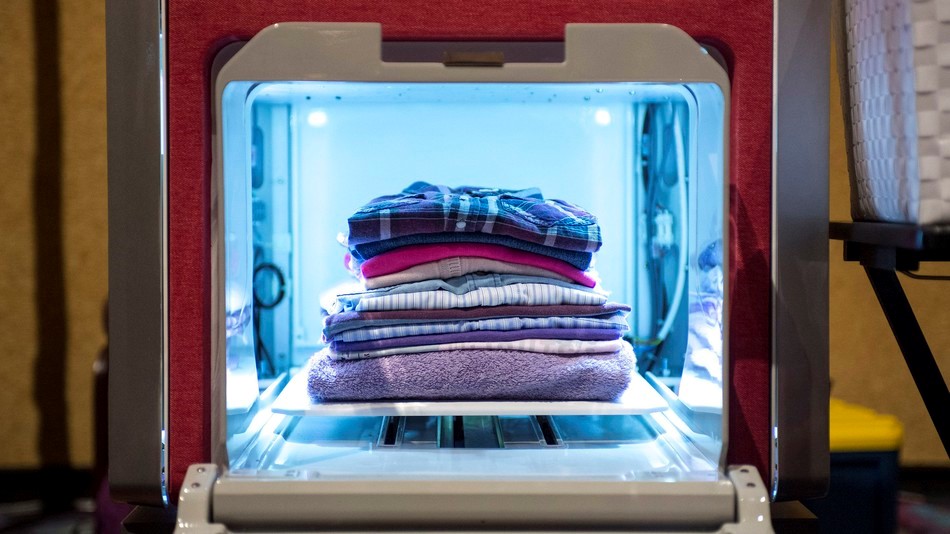As mentioned in my last blog post, I attended CES 2018. During the show, there were two product demonstrations that I would like to focus on in this blog. They offered the same general functionality but did so in a very different manner. These two devices, the Foldimate and Laundroid, both provide the capability to fold your laundry. But are these examples of AI? There is some debate about when exactly a machine is just a machine, and when it can or should be considered a robot. The Foldimate and Laundroid provide a good example for both a machine and a robot that do a similar task.
THE PRODUCTS
FOLDIMATE
The Foldimate is a prototype laundry-folding machine due to begin shipping in late 2019 with a target price of $980. The device allows you to load one piece of laundry at a time, which it will then fold and place into a bin. The folding process is relatively fast. While the actual speed is not clear, it looks to be less than 30 seconds per item. The item must be presented to the device correctly, but from there it proceeds quickly. The developers state that you can complete your laundry folding in under four minutes. My assumption is that is the amount of time it takes to fill the output bin.
With a price point in the range of a standard large consumer appliance (for example, a washer or dryer), and rapid folding, the Foldimate looks primed to be a viable product for a high-end market segment. The downside of the product is that it must be hand-fed, and does not operate in a batch mode like your washer and dryer do.
LAUNDROID
The Laundroid is very different than the Foldimate in design approach, price, and performance. First, the price point is currently prohibitive. While it touts very high-end cabinetry finishes, at a list price of $16,000, the Laundroid is out of reach for most households. The manufacturer is targeting cost reductions to hit a price point near $2,000 in the future.
The use model for the Laundroid is also quite different from the Foldimate. Instead of hand-feeding the machine item by item, you simply dump a pile of laundry into the input door and let the robotic laundry folding machine finish the job. This batch processing matches your washer/dryer experience, making the Laundroid the third appliance in the process. You get back six stacks of neatly folded laundry, potentially sorted by owner or type. On the downside, the sorting process may take up to four hours. The Laundroid app will also help you understand which of your clothes you’re wearing often, and provides other value-added features. See my previous blog CES 2018 and IoT for more details.
ROBOT OR NOT?
In Wired Magazine, Robotics Professor Anca Dragan of UC Berkeley (Go Bears!) defined a robot as:
“I would say that a robot is a physically embodied artificially intelligent agent that can take actions that have effects on the physical world”.
How do the Foldimate and the Laundroid stack up to this definition?
While the designer of the Foldimate has not made it clear exactly how the device operates, the speed and price point indicate that it is most likely a custom mechanism folding and not a robot. As such, the device’s behavior will be fixed by the design. While future versions of the product may offer enhanced features, a specific version of the device is likely not extensible to handle other items. Of course, given the optimization of the design for the job, the modest price point and high speed likely make this machine a great value proposition for the market.
If you’re looking for artificial intelligence examples, the Laundroid has two robotic arms to manipulate the laundry items. Guiding these arms is a computer vision system backed by a deep learning AI algorithm. This algorithm was trained on over 250k images of each type of laundry item that the device can handle. Given the flexibility of the arms and algorithms, the system is upgradable and adaptable. The ability to deal with the unstructured input of a jumbled drawer of clean laundry clearly makes the Laundroid a specialty robot.
The Foldimate and Laundroid are an interesting comparison of the relative benefits and drawbacks between application-specific machines and household robots. While the Laundroid offers a much better user experience than the Foldimate, it does so at a large price difference and a considerable speed penalty. It will be interesting to see how these two products continue to evolve to capture a niche application and attempt to establish themselves as the next must-have home appliance.

